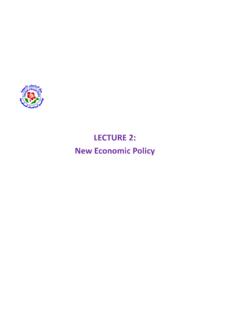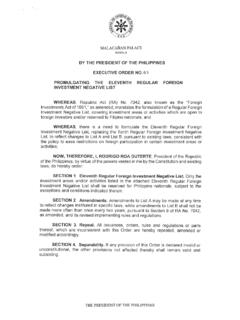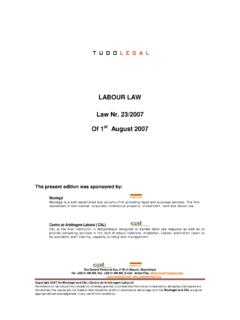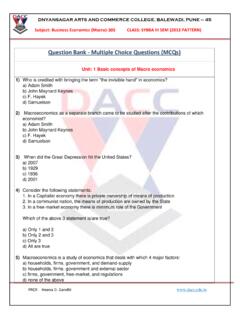Transcription of THE PORTER`S THEORY OF COMPETITIVE ADVANTAGE
1 3493 THE PORTER`S THEORY OF COMPETITIVE ADVANTAGE PAUL LAUREN IU FR SINEANU Paul Lauren iu FR SINEANU, PhD student University of Craiova Keywords: COMPETITIVE ADVANTAGE , diamond, determinants. Abstract: In this item, we approached one of the new theories of the economic development, the THEORY of COMPETITIVE ADVANTAGE . The THEORY of COMPETITIVE ADVANTAGE was created by Michael E. Porter, starting from the actual economic reality which could no longer be explained on the basis of the model of comparative advantages, elaborated by David Ricardo. In order to conceive this THEORY , Porter analyzed four years, ten countries with important share in international commerce (Denmark, Germany, Italy, Japan, South Korea, Singapore, Sweden, Switzerland, Great Britain and USA), establishing the system of the determinants which determine the obtaining of the COMPETITIVE ADVANTAGE .
2 Starting from describing the system of the determinants, the so-called diamond , we analyzed detailed these determinants of the diamond: the factorial ones, the demand ones, upstream and downstream industries and the domestic competition, and also the chance and the governmental policy. After analyzing and classifying the structure of these determinants, we approach their interaction - the dynamics of the diamond - by identifying the stages of the development which a country goes through and the features of each stage. In the last part of the article, we enumerated the causes that might lead to loosing the COMPETITIVE ADVANTAGE and the position as a leader on the market, and a few critics brought to this new THEORY .
3 1. The presentation of the THEORY of Porter The THEORY of the COMPETITIVE ADVANTAGE starts from the principle that the only important concept at the national level is the national productivity (Fota Constantin, 2004). In the elaboration of his THEORY , Porter starts from the following premises (Porter Michael, 1990): - the nature of the competition and the sources of COMPETITIVE ADVANTAGE are very different among industries and even among the segments of the same industry, and a certain country can influence the obtaining of the COMPETITIVE ADVANTAGE within a certain sector of industry.
4 - the globalisation of the competition and the appearance of the trans-national companies do not eliminate the influence of a certain country for getting the COMPETITIVE ADVANTAGE ; a country can offer different compatitive advantages for a company, depending if it is an origin country or a host country; - the competitivity has a dynamic character (Schumpeter); the innovations have a role of leading force in this permanent change and determine the companies to invest on order not to be eliminated from the market (Negri oiu Mi u, 1997 ). Starting from these premises, Porter identifies a system of determinants which is the basis for getting COMPETITIVE advantages by the nations.
5 2. The system of determinants The THEORY is based on the system of determinants, called by Porter diamond , which consists of: 3494 A) the factorial determinants - the endowment of a country with factors; B) the determinants of the demand - the features of the internal market; C) up and downstream industries; D) the strategy and structure of the companies and the rivalry among them - the domestic competition; These four determinants are considerably influenced by others two factors: the chance and the governmental policy. All these determinants are conditioned one to another.
6 According to Porter, the countries have success where the national diamond is the most favourable . The more complex and dynamic the economic environment of the country is, the more like is some companies to fail if they cannot capitalize in an adequat way the requests of this environment. A. The factorial determinants represent the starting point necessary to enter in competition. The classical economic THEORY identifies the labor, land and capital as the factors of the production. The THEORY of Porter demonstrates that, even the endowment with factors is obviously important, the critical element for a country to be COMPETITIVE is to create new factors and to improve the existing ones.
7 The COMPETITIVE ADVANTAGE should be created, it is not inherited ( Negri oiu Mi u, 1997). Porter divides the production factors into the following categories: 1) human resources - quantity, the level of instruction, the costs with the labor, the time of working, the attitude to working; 2) natural resources - abundance, quality, accesibility, the costs with land, water, mineral resources, forest; 3) knowledge resources - the supply of the scientific, technical and marketing knowledge used for creating and distributing goods and services. These knowledge are located in universities, research institutes, informational system, data banks, commercial associations, and so on; 4) capital resources - the level and the cost of the capital available for financing the industry, determined by the saving rate of the economy and the structure of the financial national market , which is different from a country to another, although we attend the globalizations of the capital markets.
8 5) infrastructure - includes not only the transport systems, post, communications, payment systems and the systems used to transfer money, but also different infrastrucure elements that determine the attractivness of a country regarding the quality of life and work conditions ( culture, health ). Considering the present conditions, when the mobility of the production factors is permanently increasing , it is less important the direct access to them, but especially the economic and financial eficacity in their allocation and use. Porter sees two categories of production factors: a) primary factors (include natural resources, climate, geografical position, qualified or not qualified labor) that can be met in all countries, but with different proportions.
9 B) advanced factors (modern informatic infrastructure, high-skilled labor, COMPETITIVE research institutes ). The most of these factors are created in time with important investments. In present, these factors are also the most important for obtaining the COMPETITIVE ADVANTAGE . But Porter draws the attention that often the advanced factors are built on the primary factors. Another classification of the production factors divides the factors by their 3495 specificity into: -generalized factors ( the transport and communications system, banking system, educated and motivated labor ) that can be used in many industries, being available in many countries; -specialized factors(high skilled labor, special infrastructure ) located into a limited number of economic sectors.
10 Their creation supposes bigger investments with a bigger level of risk, starting from the existence of the generalized factors. They are rare but critical for creating and maintaining different forms of COMPETITIVE advantages. B. The determinants of the demand have an important role for creating COMPETITIVE advantages. They influence the aquirement of the COMPETITIVE ADVANTAGE by the mix of the domestic demand. The nations win the COMPETITIVE ADVANTAGE if the domestic demand is so strong that forces the companies to innovate more rapidly than the foreign competitors in order to stay on the market.










